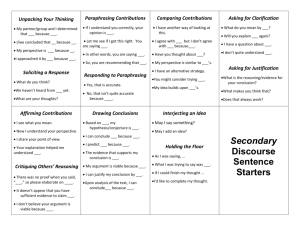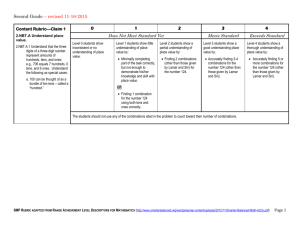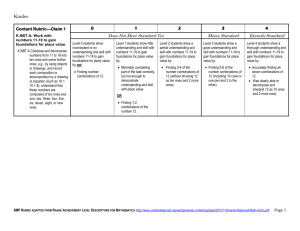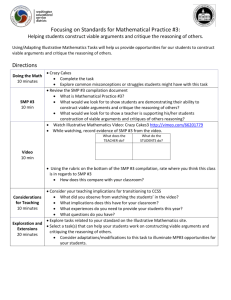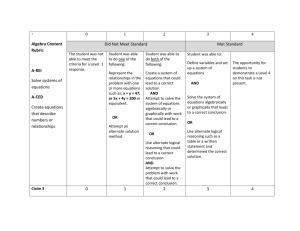1st Grade Rubric - Washington State ESDs
advertisement
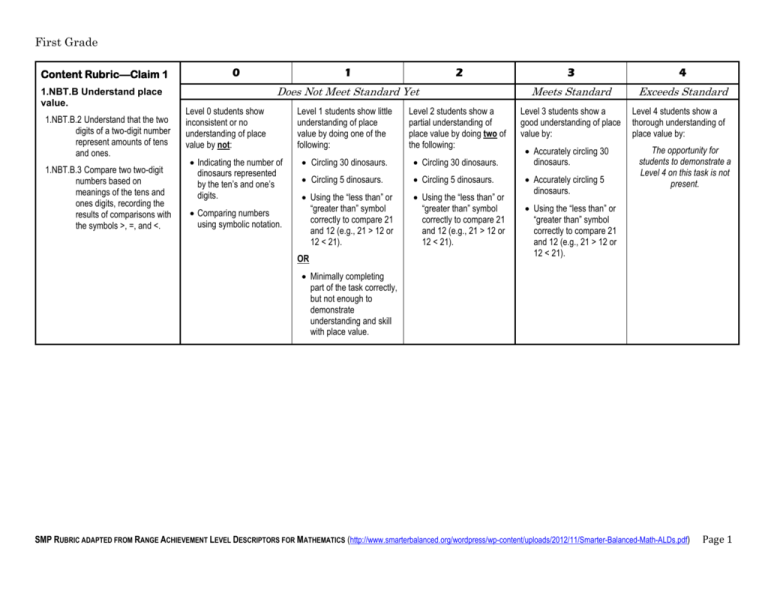
First Grade Content Rubric—Claim 1 1.NBT.B Understand place value. 1.NBT.B.2 Understand that the two digits of a two-digit number represent amounts of tens and ones. 1.NBT.B.3 Compare two two-digit numbers based on meanings of the tens and ones digits, recording the results of comparisons with the symbols >, =, and <. 0 1 2 Does Not Meet Standard Yet Level 0 students show inconsistent or no understanding of place value by not: Indicating the number of dinosaurs represented by the ten’s and one’s digits. Comparing numbers using symbolic notation. Level 1 students show little understanding of place value by doing one of the following: Level 2 students show a partial understanding of place value by doing two of the following: Circling 30 dinosaurs. Circling 30 dinosaurs. Circling 5 dinosaurs. Circling 5 dinosaurs. Using the “less than” or “greater than” symbol correctly to compare 21 and 12 (e.g., 21 > 12 or 12 < 21). Using the “less than” or “greater than” symbol correctly to compare 21 and 12 (e.g., 21 > 12 or 12 < 21). OR 3 4 Meets Standard Exceeds Standard Level 3 students show a good understanding of place value by: Accurately circling 30 dinosaurs. Accurately circling 5 dinosaurs. Level 4 students show a thorough understanding of place value by: The opportunity for students to demonstrate a Level 4 on this task is not present. Using the “less than” or “greater than” symbol correctly to compare 21 and 12 (e.g., 21 > 12 or 12 < 21). Minimally completing part of the task correctly, but not enough to demonstrate understanding and skill with place value. SMP RUBRIC ADAPTED FROM RANGE ACHIEVEMENT LEVEL DESCRIPTORS FOR MATHEMATICS (http://www.smarterbalanced.org/wordpress/wp-content/uploads/2012/11/Smarter-Balanced-Math-ALDs.pdf) Page 1 Practice Rubric—Claim 3 Claim 3 Students can clearly and precisely construct viable arguments to support their own reasoning and to critique the reasoning of others. Claim 3 Range ALD: A. Test propositions or conjectures with specific examples. B. Construct, autonomously, chains of reasoning that will justify or refute propositions or conjectures. C. State logical assumptions being used. D. Use the technique of breaking an argument into cases. E. Distinguish correct logic or reasoning from that which is flawed and—if there is a flaw in the argument—explain what it is. 0 1 2 Does Not Meet Standard Yet Level 0 students demonstrate inconsistent or no ability to clearly and precisely construct viable arguments in support of his or her reasoning or identify obvious flawed arguments in familiar contexts. Level 1 students demonstrate little ability to clearly and precisely construct viable arguments in support of his or her reasoning using concrete referents such as objects, drawings, diagrams, and actions and identify obvious flawed arguments in familiar contexts. Level 2 students demonstrate a partial ability to clearly and precisely construct viable arguments in support of his or her reasoning and should be able to find and identify the flaw in an argument by using examples or particular cases. Students should be able to break a familiar argument given in a highly scaffolded situation into cases to determine when the argument does or does not hold. 3 4 Meets Standard Exceeds Standard Level 3 students demonstrate an ability to clearly and precisely construct a viable argument in support of his or her reasoning by using stated assumptions, definitions, and previously established results and examples to test and support their reasoning or to identify, explain, and repair the flaw in an argument. Students should be able to break an argument into cases to determine when the argument does or does not hold. Level 4 students demonstrate a thorough ability to clearly and precisely construct viable arguments in support of his or her reasoning by using stated assumptions, definitions, and previously established results to support their reasoning or repair and explain the flaw in an argument. They should be able to construct a chain of logic to justify or refute a proposition or conjecture and to determine the conditions under which an argument does or does not apply. F. Base arguments on concrete referents such as objects, drawings, diagrams, and actions. G. At later grades, determine conditions under which an argument does and does not apply. (For example, area increases with perimeter for squares, but not for all plane figures.) SMP RUBRIC ADAPTED FROM RANGE ACHIEVEMENT LEVEL DESCRIPTORS FOR MATHEMATICS (http://www.smarterbalanced.org/wordpress/wp-content/uploads/2012/11/Smarter-Balanced-Math-ALDs.pdf) Page 2 Task Specific Rubric Dinosaur Compare (1st Grade) Level 0 students do not meet criteria for a level 1 Level 1 students demonstrate little ability to clearly and precisely construct viable arguments in support of his or her reasoning by: Stating how they know their comparison is a true statement. Or Attempting to explain his/her work, but the examples don’t necessarily support student reasoning, however they are still mathematically viable. Level 2 students demonstrate a partial ability to clearly and precisely construct viable arguments in support of his or her reasoning by: Stating how they know their comparison is a true statement. Giving a flawed explanation of the comparison and the way(s) they modeled 21 and 12 in their comparison of the numbers relative (e.g., drew a picture showing 21 dots compared to 12 dots or 21 has two tens and 12 has one ten). Level 3 students demonstrate an ability to clearly and precisely construct a viable argument in support of his or her reasoning by: Level 4 students demonstrate a thorough ability to clearly and precisely construct viable arguments in support of his or her reasoning by: Stating how they know their comparison is a true statement. Provides an incomplete explanation, connecting place value and the way(s) they modeled 21 and 12 in their comparison of the numbers relative (e.g., drew a picture showing 21 dots compared to 12 dots or 21 has two tens and 12 has one ten). Accurately stating how they know their comparison is a true statement. Explaining or connecting place value and the various ways they modeled 21 and 12 in their comparison of the numbers relative (e.g., drew a picture showing 21 dots compared to 12 dots and 21 has two tens and 12 has one ten). SMP RUBRIC ADAPTED FROM RANGE ACHIEVEMENT LEVEL DESCRIPTORS FOR MATHEMATICS (http://www.smarterbalanced.org/wordpress/wp-content/uploads/2012/11/Smarter-Balanced-Math-ALDs.pdf) Page 3 SMP RUBRIC ADAPTED FROM RANGE ACHIEVEMENT LEVEL DESCRIPTORS FOR MATHEMATICS (http://www.smarterbalanced.org/wordpress/wp-content/uploads/2012/11/Smarter-Balanced-Math-ALDs.pdf) Page 4

